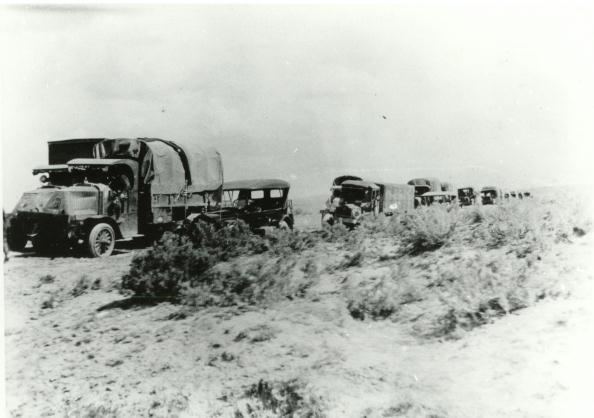 | ||
The Transcontinental Motor Convoys were early 20th century vehicle convoys, including three US Army truck trains, that crossed the United States (one was coast-to-coast) to the west coast. The 1919 Motor Transport Corps convoy from Washington, D.C., to San Francisco used the incomplete Lincoln Highway.
Contents
Background
The United States' Good Roads Movement of the late 19th century began as increased use of bicycles required better surfaces over the existing wagon and carriage roads. The development of the automobile and their increased use resulted in the formation of the United States Good Roads Association and various individual cross-country trips by individual vehicles, followed by the first transcontinental trip by a convoy of vehicles.
1915 transcontinental film convoy
The 1915 transcontinental film convoy was a 4-month motor convoy beginning August 25 and ending at the Panama–Pacific International Exposition in San Francisco. The film crew completed the "Three-Mile Picture Show" (named for the length of film). The film was directed by Henry Ostermann, Consul at Large for the Lincoln Highway Association, who travelled in a Stutz touring car.
1919 Motor Transport Corps convoy
The 1919 Motor Transport Corps convoy was a "Truck Train" of the US Army Motor Transport Corps that drove over 3,000 mi (4,800 km) from Washington, D.C. (departing July 7th), to Oakland, California, and ferried to San Francisco. In addition to 230 road incidents (stops for adjustments, extrications, breakdowns, & accidents) resulting in 9 vehicles retiring, the convoy of "24 expeditionary officers, 15 War Department staff observation officers, and 258 enlisted men" (e.g., Bvt Lt Col Dwight D. Eisenhower of the Tank Corps) had 21 injured en route who did not complete the trip. Although some "were really competent drivers" by the end, the majority of soldiers were "raw recruits with little or no military training"; and except for the Motor Supply Company E commander (1st Lt Daniel H. Martin), troop officers had "meager knowledge" of "handling men in the field".
The convoy broke and repaired 88 wooden bridges (14 in Wyoming), and "practically" all roadways were unpaved from Illinois through Nevada. The convoy logged 3,250 mi (5,230 km) miles in 573.5 hours (5.67mph avg.). and 6 rest days without convoy travel were used. Convoy delays required extra encampments and, at Oakland, California, the convoy was 7 days behind schedule (ferrying the next morning on the last travel day).
1919 Air Service Transcontinental Recruiting Convoy
The 1919 Air Service Transcontinental Recruiting Convoy was a "mobile army post".[11] of over 1/2 mile long to support 13 aircraft from Hazelhurst Field to California beginning August 14, 1919. The mission of the All American Pathfinders was "to secure accurate information to be used in connection with the carrying of mails by airplanes, and for military purposes, as well as commercial purposes."
1920 Motor Transport Corps convoy
The 1920 Motor Transport Corps convoy left Washington, D.C. on 14 June 1920 and followed the Bankhead Highway to San Diego, California, where it arrived on 2 October. A smaller expedition than the first, the second convoy consisted of 50 vehicles, 32 officers, and 160 enlisted men under Col John F. Franklin. A rate of 45–60 miles per day was initially estimated, commensurate with that of the first convoy.
The convoy's trip proceeded smoothly as far as Atlanta. However, as it moved west into Tennessee, its progress slowed. Detours became necessary due to flooding and the crossing of the "black gumbo" of the Mississippi River proved very problematic. Despite high hopes, the Southern United States proved to be the worst part of the trip. The convoy encountered almost impassable sands between Maricopa and Wellton, Arizona.
Like the first convoy, at every stop the expedition was met by local celebrations and dances. After 111 days and an average rate of less than 30 miles per day, the convoy reached the West Coast where an officer's banquet was given in San Diego. After its arrival in San Diego, the convoy then went north to Los Angeles and was broken up, its equipment distributed to California's public services as part of a program to make use of war surplus.
The officers of the expedition became convinced by their experience that the maintenance of a national highway system should be the province of the federal government, as supported by the Townsend Bill. However, despite the widespread friendly greetings received by the convoys across the nation, neither generated enough public support to ensure passage of the Townsend Bill, which failed and was replaced by the Federal Highway Act of 1921. Both convoys are identified on the Zero Milestone on the Ellipse in Washington, D.C.
2009 commemoration of 1919 convoy
In the summer of 2009, on the 90th anniversary of the original trek, the Military Vehicle Preservation Association sponsored a re-enactment of the 1919 convoy. Beginning June 10, following the original route as much as possible and duplicating the original schedule, the convoy set out from Washington, D.C. Over the length of the convoy, more than 150 historic military vehicles, including fifty military jeeps, nineteen ¾ ton trucks, seven 1½ ton trucks, six 2½ ton trucks, three cargo trucks, nine motorcycles, and four sedans took part. The oldest vehicle to take part was a 1917 four-wheel drive 3 ton ammunition truck.
The reenactors had three purposes: along with retracing the route of 1919 convoy over the historic Lincoln Highway, they paid tribute to the U.S. military and commemorated the 200th anniversary of the birth of President Abraham Lincoln.
